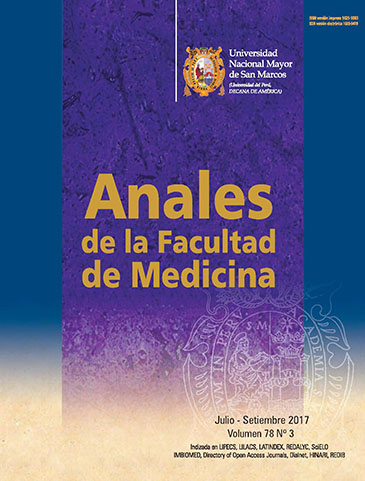Medicinal plants used for treatment of skin diseases in rural communities in Los Ríos province, Ecuador
DOI:
https://doi.org/10.15381/anales.v78i3.13767Keywords:
Skin Diseases, Plants, Medicinal, Therapeutic Uses.Abstract
Introduction: Skin diseases occupy the third place among the ten causes of general morbidity in Ecuador, and traditional medicine practices are the most frequent therapeutic options in rural sectors. Objective: To identify the medicinal plants used for treatment of skin diseases. Design: Descriptive, cross-sectional study. Place: Two rural Babahoyo city parishes named Pimocha and Febres-Cordero, and located south of the Los Ríos province, Ecuador. Participants: Persons responsible for family care consisted in 198 women (61.7%) and 123 men (38.3%), 17 to 76 years old. Interventions: Previous informed consent, direct observations, interviews and surveys were conducted; the U-PlanMed questionnaire was used. Main outcome measures: Plant species and therapeutic uses. Results: Ten species of plants and their therapeutic applications for skin diseases were identified, such as acne, burns, pruritus, rash, dermatitis, ulcerations of the skin (sores), stains, and skin care. Conclusions: 100% of the population used medicinal plants for the treatment of skin conditions, mainly Aloe vera, Chamaemelum nobile, Melissa officinalis and Scoparia dulcis.Downloads
Published
2017-11-30
Issue
Section
Artículo Original
License
Copyright (c) 2017 Maritza Gallegos-Zurita, Diana Gallegos-Z

This work is licensed under a Creative Commons Attribution-NonCommercial-ShareAlike 4.0 International License.
Those authors who have publications with this magazine accept the following terms:
- Authors will retain their copyrights and guarantee the journal the right of first publication of their work, which will be simultaneously subject to Creative Commons Attribution License that allows third parties to share the work as long as its author and its first publication this magazine are indicated.
- Authors may adopt other non-exclusive licensing agreements for the distribution of the version of the published work (eg, deposit it in an institutional electronic file or publish it in a monographic volume) provided that the initial publication in this magazine is indicated.
- Authors are allowed and recommended to disseminate their work over the Internet (eg: in institutional telematic archives or on their website) before and during the submission process, which It can produce interesting exchanges and increase quotes from the published work. (See El efecto del acceso abierto ).
How to Cite
1.
Gallegos-Zurita M, Gallegos-Z D. Medicinal plants used for treatment of skin diseases in rural communities in Los Ríos province, Ecuador. An Fac med [Internet]. 2017 Nov. 30 [cited 2024 Jul. 17];78(3):315-21. Available from: https://revistasinvestigacion.unmsm.edu.pe/index.php/anales/article/view/13767















